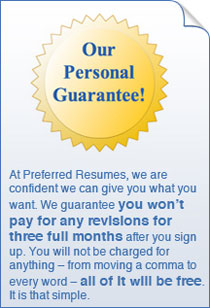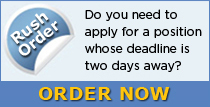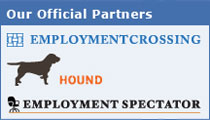Addressing Red Flags and Weaknesses in your Resume
|
|
A red flag is anything that might cause an employer to question your work history or to think poorly of you as a candidate. This could be an employment gap, frequent job changes, a particularly short tenure at one or more positions, or the termination of a position. Other factors that may weaken you as a candidate include lack of experience, too much experience, age, or an unfocused work history. The cover letter is often your best forum for addressing flaws in your candidacy since it allows you to explain yourself directly. But there are some things that can be done within your resume's format and layout that are also effective in minimizing any weaknesses.
A. Job-hopping
Although the concept of working for the same employer from graduation until retirement is becoming more and more of an oddity, employers still name job stability as one of the most important factors they seek in a candidate. Anyone who goes into an interview saying, "I think I'll give this job a year or two and then jump ship for a higher salary," will be immediately shown the door.
Therefore, a resume that is "all over the place" is a turnoff. If you have changed jobs frequently, changed career paths more than once, or lived in a different state every year, you may appear somewhat unstable to employers. For this reason, you want to focus on either structuring your resume in such a way that your instability is not apparent or on explaining your moves so that employers understand your motives.
If the reason for your move was due to the sale, merger, or closing of your company or firm, it is perfectly fine to indicate as much on your resume. A simple parenthetical that says (company/firm disbanded in July 2000) will be enough to convey that you were a victim of circumstances beyond your control. If the reason for your frequent moves was due solely to your own devices, however, you may want to employ some of the following techniques to minimize your transience.
1) Do not make dates/locations the center of attention.
Rather than putting the dates on the right side, where they stand out, put them at the end of the title of your job.
Compare:
Smith Construction Company , Atlanta , GA, 2002-Present, Manager
With:
Manager
Smith Construction Company
Atlanta , GA , 2002-Present
The bottom layout puts more emphasis on the job title and less on the geographic and timeline information. While the information is still given, it is not quite as prominent.
2) Do not make your resume look like a laundry list.
If you find your list of jobs extending beyond five or six, you should either eliminate some of the older positions or create a format that places more emphasis on accomplishments and less on dates and employers. You can also use a summary section and reduce the amount of space given to older positions.
B. Lack of Experience
Regardless of how inexperienced you are, you need your resume to fill up one page. Nothing highlights lack of experience like a resume that is only three-quarters full.
First, make sure that you have fleshed out your content as much as possible. Keep in mind that "experience" does not have to refer to professional experience in the workplace. Maybe you have participated heavily in volunteer activities or held a significant role in a campus organization. These activities can be included to show leadership and initiative. You can also emphasize any activities you participated in during school, particularly if they involved organization, managing personnel or budgets, or writing.
If you have fleshed out your content as much as possible and you are still struggling with filling up a page, here are some layout tricks you can try:
1) Bullet points
Breaking your experience up with bullet points is a quick way to make it look more substantial on the page.
2) Tabs
Using tabs to center your text on the page can also make your resume look fuller. In addition, margins, spacing, fonts, and headings can be adjusted in order to make your resume fit evenly across the page.
C. Age
The issue of age comes up very frequently when discussing job-seekers' concerns about their candidacy. Almost all, the issue has to do with a fear of being too old to employers, as opposed to too young.
Of course, these issues are all relative to the type of position you are seeking. If you are 40 years old with 15 years of experience and are seeking a senior position, then your age and experience will be a boon, not a hindrance. However, if you are 40 and just entering a new profession or you want to make a career change within the industry, you may face obstacles.
If you feel that your age may stand in the way of your dream job, you should strategize a way to minimize your age on your resume. The most obvious way to do this is to remove the graduation dates. It is generally assumed that the date you earned your undergraduate degree represents the time you were about 22 years old. This is NOT recommended, however, as more and more often people are padding their resumes with degrees they never obtained or work they never performed. This is actually good. If there weren't checks and balances in place, everyone applying for a job would be a valedictorian from Harvard.
As a result, employers are becoming more diligent about checking backgrounds. If they don't see graduation dates, this omission itself could be a red flag. They could assume that you didn't actually obtain the degree, but rather worked toward it. Or if you are only 35, you do not want to give someone the impression that you are 55 and concealing it. The best way to decide what to do is to have someone objective view your resume and tell you what he/she infers about your age from reading it. Providing such information can be the key to assuring employers that all information on your resume is valid.
Other ways to minimize dates were mentioned in the section on job-hopping. Including dates beside job titles or degrees rather than separating them will make them less obvious. Also avoid quantifying your experience. If your resume starts with "More than 30 years of experience handling complex litigation," you are immediately pointing out your age to the reader.
Finally, it is important that you have an up-to-date, sharp-looking resume. Certain outdated fonts, word usage, and layouts can give you away as "out of touch." Invest some time and energy and perhaps money in making your resume look as "hip" as possible.
D. Unfocused Work History
You took Position A because it was the first thing you were offered out of school. Then you moved to Position B because you wanted more money. Then Position C came along, and it gave you an opportunity to do what you really wanted to do, or so you thought. Position C was not all it was cracked up to be, so you went on to Position D because the skills you developed in Position C lent themselves pretty well to D type of work.
Now you are in a position where you have experience and you really know (this time) what you want to do, but your resume portrays you as someone who is a little too well rounded. It is important that your career path make sense to the person reading your resume even if it does not make sense to you. The employer should get the sense that each thing you have done has been part of an overall plan, and not just the result of random happenstance. If you worked as a writer in publishing, then as a translator, then as a marketing/sales rep, it was because you wanted to showcase your versatility as a writer; not because you simply lacked direction.
Therefore, it is essential that you create a summary section that ties together your experience. You should play up your versatility. Point out that you are experienced in a variety of environments and have a deep understanding of different industries' requirements. You should also play up your ability to quickly learn about and adapt to new subjects easily.
If you have some positions on your resume that you think will cause people to say, "Huh?" go ahead and remove them. While job-seekers tend to fret over gaps in employment, sometimes a gap is a lesser evil than a position that raises a red flag. If you did some house cleaning or took a temporary job in a dentist's office between jobs, it will just confuse employers to see that on your resume.
In addition to the examples in this section, there are plenty of other resume scenarios that might merit some significant brainstorming and strategizing. While it would be impossible to cover them all, the tips we have given you should get you thinking in the right direction. Almost any weakness can be effectively minimized, or even turned into a strength. Remember that there is rarely such a thing as a perfect candidate for a position and that employers are human beings who have had their own ups and downs in their careers. Employers have also left positions, been victims of downsizing, and/or made career moves that were not the smartest. So do not dwell on what is lacking in your resume. Instead, focus on making your strengths so prominent that your weaknesses are completely overshadowed.




